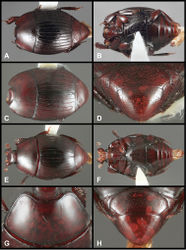Crenulister grossus
| Notice: | This page is derived from the original publication listed below, whose author(s) should always be credited. Further contributors may edit and improve the content of this page and, consequently, need to be credited as well (see page history). Any assessment of factual correctness requires a careful review of the original article as well as of subsequent contributions.
If you are uncertain whether your planned contribution is correct or not, we suggest that you use the associated discussion page instead of editing the page directly. This page should be cited as follows (rationale):
Citation formats to copy and paste
BibTeX: @article{Caterino2014ZooKeys381, RIS/ Endnote: TY - JOUR Wikipedia/ Citizendium: <ref name="Caterino2014ZooKeys381">{{Citation See also the citation download page at the journal. |
Ordo: Coleoptera
Familia: Histeridae
Genus: Crenulister
Name
Crenulister grossus Caterino & Tishechkin, 2014 sp. n. – Wikispecies link – ZooBank link – Pensoft Profile
Type locality
BRAZIL: Mato Grosso, Fazenda São Nicolau [9.8386°S, 58.2508°W].
Type material
Holotype male: “BRASIL: Mato Grosso: Mpio Cotriguaçu, Fazenda São Nicolau, Matinha. 9°50.3'S, 58°15.05'W. Flight intercept Oct 2009. F.Z.Vaz-de-Mello” / “Caterino/Tishechkin Exosternini Voucher EXO-03022” (CEMT). Paratypes (6): 1 same data as type, 2: same locality as type, but xii.2010; 3: Mato Grosso: Mpio Cláudia, 11°24.5'S, 55°19.5'W, FIT, 17–27.x.2010, A.F.Oliveira (CEMT, UFPR, FMNH, MSCC).
Diagnostic description
Length: 2.6–3.2 mm, width: 2.4–2.8 mm; as for generic description, with the following diagnostic characters: body rufopiceous, elongate ovoid, moderately convex; frontal stria fine but complete across middle, frontal disk rather strongly depressed, with a few sparse secondary punctures, mostly toward vertex; epistoma with oblique lateral ridges delimiting median depression, but not striate; labrum about 5× wider than long, apical margin shallowly, broadly emarginate; pronotum with gland opening track extending posterad just beyond midpoint, with 3-4 openings along its length, substriate; pronotal sides moderately explanate along smooth, non-crenulate lateral submarginal stria; pronotal disk with numerous, large secondary punctures in basal third, most strongly concentrated and extending slightly further forward at middle, sides almost entirely smooth; prescutellar impression not evident; elytron with single, complete, crenulate epipleural stria, all dorsal striae complete, very coarsely impressed, appearing chain-like; elytral intervals very sparsely, irregularly punctate, most intervals with 4-6 punctures; prosternal keel with faint secondary striae alongside complete, anteriorly united carinal striae; prosternal lobe deflexed in apical half, with marginal stria present only at middle; mesoventrite with marginal stria weakly crenulate, mesometaventral stria more coarsely so and arched forward just beyond mesoventral midpoint; postmesocoxal stria recurved anterad around mesocoxa but ending short of mesepimeron; lateral metaventral stria crenulate, reaching middle of metacoxa, recurved mediad apically in some individuals; mesoventrite entirely and more or less uniformly coarsely punctate; metepisternal punctures independent, not forming a stria; punctures of 1st abdominal ventrite mostly uniform, only transversely elongate along posterior margin; marginal punctures of ventrites 2–4 similarly elongate, but mostly separate, not or only intermittently coalescing into marginal striae; protibia 7-spined, with marginal dentation very weakly developed; meso- and metatibiae with 4-5 spines each, mainly in apical half; propygidium with secondary punctures shallow, very sparse, separated by 1-3× their diameters, densest in basal half; propygidial gland opening associated with very weak oblique striole in anterior corners; pygidial punctation weak, punctures much smaller and sparser than those of propygidium, more or less uniformly separated by about 4× their diameters throughout; pygidial gland openings evident at sides about one-fourth from base, marginal striae absent. Male (Fig. 20): accessory sclerites absent; T8 with ventrolateral apodemes strongly narrowed beneath; S8 with halves meeting only at basal corner, inner margins short and strongly divergent, with about 5 strong setae toward apex; T9 with apices obliquely truncate; T10 apically emarginate; S9 truncate, quadrate at base, apex narrowly and rather deeply emarginate; tegmen widest in basal third, narrowed to apex, apices slightly separated, medioventral process produced beneath about one-fourth from base; median lobe about one-third tegmen length, basal piece short, about one-fourth tegmen length.
Remarks
This is the largest species of Crenulister, and between its size (Fig. 19A–B), coarse punctation, and very coarsely impressed elytral striae, one of the easiest to recognize.
Etymology
This species name refers to its relatively large size, and secondarily its occurrence in Mato Grosso, Brazil.
Original Description
- Caterino, M; Tishechkin, A; 2014: New genera and species of Neotropical Exosternini (Coleoptera, Histeridae) ZooKeys, 381: 11-78. doi
Images
|


